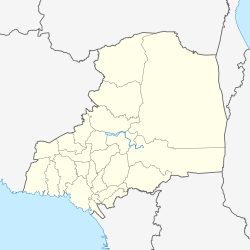| Obando Church | |
|---|---|
| San Pascual Baylón Parish and National Shrine of Nuestra Señora de la Immaculada Concepcion de Salambao | |
 The main facade in August 2023 | |
| 14°42′38″N 120°56′13″E / 14.710556°N 120.937028°E | |
| Location | Obando, Bulacan |
| Country | Philippines |
| Denomination | Roman Catholic |
| History | |
| Former name(s) | San Pascual Baylón Parish-Diocesan Shrine of Nuestra Señora de la Immaculada Concepcion de Salambao |
| Status | Parish church and National Shrine |
| Founded | April 29, 1754 |
| Founder(s) | Fray Manuel De Olivencia |
| Dedication | Paschal Baylon |
| Cult(s) present | Our Lady of Salambao |
| Events | Obando Fertility Rites |
| Architecture | |
| Functional status | Active |
| Architectural type | Church building |
| Completed | 1947 |
| Administration | |
| Province | Manila |
| Diocese | Malolos (since 1962) |
| Deanery | St. Francis of Assisi |
| Parish | St. Paschal Baylon |
| Clergy | |
| Priest(s) | Proceso Espiritu |
| Assistant priest(s) | Ramon Bong P. Sabangan |
The San Pascual Baylón Parish and National Shrine of Nuestra Señora de la Immaculada Concepcion de Salambao, commonly known as Obando Church,[1][2] is a Roman Catholic church located in the municipality of Obando in the province of Bulacan, Philippines. It is under the jurisdiction of the Diocese of Malolos.
Founded by Franciscan missionaries, under the Spanish Empire, it is the venue of the three-day Obando Fertility Rites held annually in honor of three patron saints, namely: St. Pascual Baylon, St. Claire of Assisi and Our Lady of Salambao,[3] a celebration that was mentioned by Jose Rizal, the Philippine national hero, in the pages of his Spanish-language novel, the Noli Me Tangere (in Chapter 6: Captain Tiago). During the month of May, parishioners and other devotees perform the three-day Obando Dance (formerly known as the Kasilonawan, now locally called Sayaw sa Obando, literally "the dance in Obando") inside the church, followed by a street procession.[4]
- ^ Cite error: The named reference
Visitawas invoked but never defined (see the help page). - ^ "Kasaysayan ng Simbahan ng Obando." (History of the Obando Church), Obando, Bayang Pinagpala! (Obando, Blessed Town!), Pamahalaang Bayan ng Obando (Local Government of Obando), 2006/2007
- ^ Cite error: The named reference
Wowwas invoked but never defined (see the help page). - ^ Cite error: The named reference
Teleguamwas invoked but never defined (see the help page).


